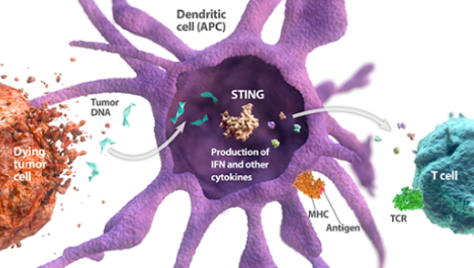STING

STING(Stimulator of interferon genes)は、腫瘍における炎症と抗腫瘍免疫応答を増強します。STINGの活性化により、腫瘍微小環境における炎症が促進されるとともに、T細胞では活性化状態が増強されます。
発現および生理的な機能
- STINGは、樹状細胞(DC)やマクロファージを含む、抗原提示細胞(APC)
 で発現する細胞内タンパク質です1,2。
で発現する細胞内タンパク質です1,2。 - STINGは、APCを刺激して細胞傷害性T細胞
 の活性化を誘導する、自然免疫活性化因子です2。
の活性化を誘導する、自然免疫活性化因子です2。
細胞内の感知タンパク質が病原体や死にゆくがん細胞のDNAを検出したときに活性化されます3,4。 - STINGの活性化は、インターフェロン(IFN)、腫瘍壊死因子α(TNFα)等の抗腫瘍免疫を増強する炎症性サイトカインの産生および分泌をもたらします3,5。
IFNにより、APCが刺激されてT細胞が活性化し、T細胞の増殖、腫瘍微小環境への遊走を惹起し、腫瘍における炎症が増強されます6,8。
IFNにより、メモリーT細胞の生存が促進されるとともに、ナチュラルキラー(NK)細胞および細胞傷害性T細胞の抗腫瘍免疫応答が増強されます2,9,10。 - STINGはNLRP3(Nucleotide-binding oligomerization domain-like receptor family, pyrin domain-containing 3)インフラマソームも活性化し、サイトカインのさらなる産生を促します11。
がんでの役割
- STINGの発現低下は、がんの転移との関連が示唆されています12-14。
前臨床のエビデンス
- 前臨床試験データでは、STINGの活性化はT細胞プライミングを増やし、活性化したT細胞の増加と腫瘍微小環境の炎症をもたらすことが示唆されています4,6-8。
- さらに、マウスモデルでは、STINGの活性化と免疫チェックポイント受容体の阻害を組み合わせることで抗腫瘍免疫応答が相乗的に増強されることが示されています15,16。
REFERENCES–STING
- Barber GN. STING-dependent cytosolic DNA sensing pathways. Trends Immunol. 2014;35(2):88-93.
- Corrales L, McWhirter SM, Dubensky TW Jr, Gajewski TF. The host STING pathway at the interface of cancer and immunity. J Clin Invest. 2016;126(7):2404-2411.
- Corrales L, Gajewski TF. Molecular pathways: targeting the stimulator of interferon genes (STING) in the immunotherapy of cancer. Clin Cancer Res. 2015;21(21):4774-4779.
- Woo S-R, Fuertes MB, Corrales L, et al. STING-dependent cytosolic DNA sensing mediates innate immune recognition of immunogenic tumors. Immunity. 2014;41(5):830-842.
- Curran E, Chen X, Corrales L, et al. STING pathway activation stimulates potent immunity against acute myeloid leukemia. Cell Rep. 2016;15(11):2357-2366.
- Corrales L, Glickman LH, McWhirter SM, et al. Direct activation of STING in the tumor microenvironment leads to potent and systemic tumor regression and immunity. Cell Rep. 2015;11(7):1018-1830.
- Woo S-R, Corrales L, Gajewski TF. The STING pathway and the T cell-inflamed tumor microenvironment. Trends Immunol. 2015;36(4):250-256.
- Ohkuri T, Ghosh A, Kosaka A, et al. STING contributes to anti-glioma immunity via triggering type-I IFN signals in the tumor microenvironment. Cancer Immunol Res. 2014;2(12):1199-1208.
- Swann JB, Hayakawa Y, Zerafa N, et al. Type I IFN contributes to NK cell homeostasis, activation, and antitumor function. J Immunol. 2007;178(12):7540-7549.
- Zitvogel L, Galluzzi L, Kepp O, Smyth MJ, Kroemer G. Type I interferons in anticancer immunity. Nat Rev Immunol. 2015;15(7):405-414.
- Gaidt MM, Ebert TS, Chauhan D, et al. The DNA inflammasome in human myeloid cells is initiated by a STING-cell death program upstream of NLRP3. Cell. 2017;171(5):1110-1124.
- Song S, Peng P, Tang Z, et al. Decreased expression of STING predicts poor prognosis in patients with gastric cancer. Sci Rep. 2017;7:39858. doi:10.1038/srep39858.
- Xia T, Konno H, Ahn J, Barber GN. Deregulation of STING signaling in colorectal carcinoma constrains DNA damage responses and correlates with tumorigenesis. Cell Rep. 2016;14(2):282-297.
- Xia T, Konno H, Barber GN. Recurrent loss of STING signaling in melanoma correlates with susceptibility to viral oncolysis. Cancer Res. 2016;76(22):6747-6759.
- Fu J, Kanne DB, Leong M, et al. STING agonist formulated cancer vaccines can cure established tumors resistant to PD-1 blockade. Sci Transl Med. 2015;7(283):283ra52. doi:10.1126/scitranslmed.aaa4306.
- Ghaffari A, Peterson N, Khalaj K, et al. STING agonist therapy in combination with PD-1 immune checkpoint blockade enhances response to carboplatin chemotherapy in high-grade serous ovarian cancer. Br J Cancer. 2018;119(4):440-449.
















